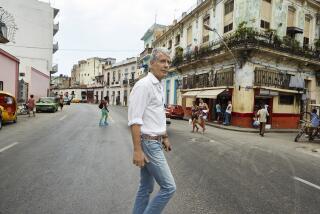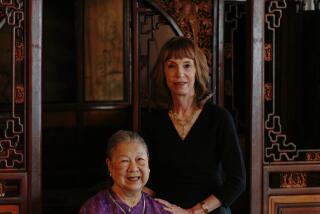The Other America : THERE ARE NO CHILDREN HERE: The Story of Two Boys Growing Up in the Other America, <i> By Alex Kotlowitz (A Nan A. Talese Book/Doubleday: $21.95; 320 pp.)</i>
Early in his impressive and unsettling book, “There Are No Children Here,” Alex Kotlowitz describes a suburban commuter train passing through Chicago’s bleak West Side slums. A boy from a nearby housing project, who has been playing along the tracks, begins sobbing, for he has been told the passengers will shoot at trespassers. Those same passengers pull back from the windows, afraid that ghetto snipers will strike.
What Kotlowitz delivers in the scene is nothing less than a paradigm for race relations in America today. In place of dialogue or even physical proximity, blacks and whites largely occupy separate realms of ignorance and terror. The black middle class, although it is growing, still returns at the workday’s end to generally segregated neighborhoods. And the black population that remains mired in poverty, generation after generation, a population that has been growing fastest of all, has become in even sympathetic white eyes a species less than human. The term “underclass,” coined by Gunnar Myrdal as a call to social action, has evolved instead into a voguish locution of distance and dismissal.
In chronicling the lives of two brothers in the Henry Horner projects, Kotlowitz has achieved a triumph of empathy as well as a significant feat of reporting. From Jacob Riis on, many of the journalists and reformers who have championed social change have done so by depicting the poor and wretched. It takes a keener mind and a bigger heart to meet these people on their own terms, as people.
In many ways, after all, the family in Kotlowitz’s book fulfills every stereotype of the “underclass.” LaJoe Rivers, a divorced and jobless woman of 35, has eight children, the first of whom she bore at age 14. Her former husband, an unemployed bus driver, is losing his battle against drugs and alcohol. One daughter is a junkie. A son is in jail. Another son appears headed there, having been arrested 46 times by the age of 18. The family lives in a fetid housing project dominated by young, vicious drug cartels. LaJoe spends part of her precious welfare allowance on a burial-insurance policy for five of her children.
Kotlowitz focuses most closely on two of those children--Lafeyette, who is 10 when the book opens in the summer of 1987 and 12 when it ends, and Pharoah, who grows from 7 to 9. In attending to the minutiae of their lives, he documents all the forces that conspire to crush them and, by extension, millions of their peers across the country.
His villains range from gangs to the police, from an overwhelmed juvenile-justice system to a historically racist public-housing authority, and in every case, Kotlowitz hangs his arguments on first-hand observation and thorough research. His point, I suspect, is not to remove responsibility from LaJoe, a defeated woman, but rather to pose the rhetorical question to whites inclined to judgment: Just what would you do in her place?
The narrative cunningly arches from an opening scene of affecting innocence, as Lafeyette and Pharoah search for a garter snake to keep as a pet, to a climax in which a family-court judge finds Lafeyette guilty of delinquency. Between those poles, Kotlowitz closely watches every increment of behavior and character. When Pharoah develops a stutter or Lafeyette withdraws into cynicism, it is clear these are not merely adolescent phases. The boys’ very humanity is beginning to collapse. “I don’t have friends,” Lafeyette tells his mother at one point. “Just associates. Friends you trust.”
One need not wonder why trust comes so hard, reading Kotlowitz’s account of the Rivers’ world. The Henry Horner project, once bustling with Scout troops and community gardens, is by the 1980s almost uninhabitable. Basic appliances break and remain unrepaired, even as once-new stoves rust in the basement, surrounded by rotting animal carcasses. The array of social programs that once served the community has vanished with budget cuts, and the Reagan-era safety net seems like nothing but the sum of its holes.
A gang called the Conservative Vice Lords operates the major business in the neighborhood, retailing heroin and cocaine. Its leader, Jimmy Lee, exists by default as the male role model of choice for Henry Horner’s young people. While reaping as much as $100,000 weekly from his drug operation, Lee lectures his admirers on the evils of drugs and gangs and gives dollar bills and new shoes to youngsters in need.
Even that image suggests far more order than actually exists. Lethal violence pervades Henry Horner--between competing drug outfits, between criminals and the police, between individuals nursing various grievances. Two feuding acquaintances of the Rivers’ burst into gunfire inside the family’s apartment. A 15-year-old friend of Lafeyette’s, known by the nickname Bird Leg, is executed by a gang.
More disturbing still is the death of Craig Davis, a promising young man from a nearby housing project who had delighted the residents of Henry Horner by playing deejay outdoors on summer afternoons. Police officers see Davis fleeing the vicinity of a robbery and give chase; an officer subduing him slips on ice and his weapon discharges into Davis’ head. And in Kotlowitz’s scrupulous reconstruction of the event, it appears highly doubtful that Davis participated in a robbery; rather, he was running away to avoid any encounter with the police, who are both loathed and desired in the slums.
How heartbreaking it is, then, to read amid the commonplace brutality Kotlowitz’s accounts of LaJoe leading her children downtown to swoon over Christmas decorations, of Pharoah finishing second in a school spelling bee, of Lafeyette watching a talent show at the neighborhood Boys Club. Even as he reminds us of the brothers’ spunk and spirit, Kotlowitz refuses to encourage any romantic notions of deliverance. Consider this paragraph late in the book:
“For the first time, Pharoah, now ten, began to wonder aloud about being black. ‘Do all black people live in projects?’ he asked his mother. ‘Do all black people be poor?’ He was upset that Michael Dukakis hadn’t chosen Jesse Jackson as his running mate. ‘He might of won then,’ he thought out loud. ‘Why don’t people elect black people?’ The incident at the stadium (when a police officer called Lafeyette a “nigger”) had unnerved him. He felt that ‘the police probably don’t like black children or something. The white polices don’t like the black children. That’s what I believe.’ It was the first time Pharoah had acknowledged any bitterness toward anybody.”
The Rivers’ story may be familiar to some readers. As an urban-affairs reporter for the Wall Street Journal, Kotlowitz first wrote about Lafeyette and Pharoah in a series of articles in 1987 and 1988, which deservedly won the Robert F. Kennedy Award for Coverage of the Disadvantaged. In expanding those articles into book form, he has generally performed well. The narrative functions as a cohesive whole, not a collection of shorter pieces hastily stitched together. Kotlowitz weaves short histories of Chicago’s education, housing, politics and public policy seamlessly into the larger plot, although the book would have benefited from some discussion of how the demise of hard industry has devastated poor, black neighborhoods.
Kotlowitz’s prose, however, rarely rises above a serviceable plane. He also manifests an unfortunate weakness for the hackneyed, from opening the book with Langston Hughes’ poem “Dream Deferred” to employing phrases such as “the silence was deafening,” “like the Pied Piper’s followers” and “in her heart of hearts.” At those moments, an editor should have saved Kotlowitz from himself.
But “There Are No Children Here” finally attests to how unimportant writing, as a free-standing discipline, truly is. More elegant books say far less than this one. Kotlowitz has conceived and reported with such intelligence and passion that his pedestrian language need only convey his social vision, which is complex, tragic, and mercifully humane.
More to Read
Sign up for our Book Club newsletter
Get the latest news, events and more from the Los Angeles Times Book Club, and help us get L.A. reading and talking.
You may occasionally receive promotional content from the Los Angeles Times.






